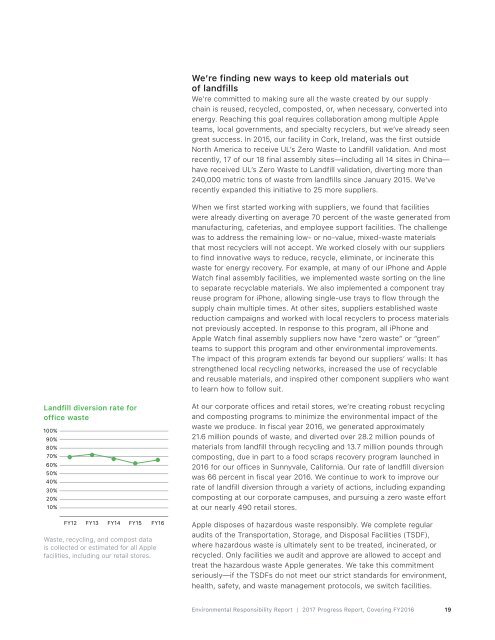Apple Environmental Responsibility Report
Create successful ePaper yourself
Turn your PDF publications into a flip-book with our unique Google optimized e-Paper software.
We’re finding new ways to keep old materials out<br />
of landfills<br />
We’re committed to making sure all the waste created by our supply<br />
chain is reused, recycled, composted, or, when necessary, converted into<br />
energy. Reaching this goal requires collaboration among multiple <strong>Apple</strong><br />
teams, local governments, and specialty recyclers, but we’ve already seen<br />
great success. In 2015, our facility in Cork, Ireland, was the first outside<br />
North America to receive UL’s Zero Waste to Landfill validation. And most<br />
recently, 17 of our 18 final assembly sites—including all 14 sites in China—<br />
have received UL’s Zero Waste to Landfill validation, diverting more than<br />
240,000 metric tons of waste from landfills since January 2015. We’ve<br />
recently expanded this initiative to 25 more suppliers.<br />
When we first started working with suppliers, we found that facilities<br />
were already diverting on average 70 percent of the waste generated from<br />
manufacturing, cafeterias, and employee support facilities. The challenge<br />
was to address the remaining low- or no-value, mixed-waste materials<br />
that most recyclers will not accept. We worked closely with our suppliers<br />
to find innovative ways to reduce, recycle, eliminate, or incinerate this<br />
waste for energy recovery. For example, at many of our iPhone and <strong>Apple</strong><br />
Watch final assembly facilities, we implemented waste sorting on the line<br />
to separate recyclable materials. We also implemented a component tray<br />
reuse program for iPhone, allowing single-use trays to flow through the<br />
supply chain multiple times. At other sites, suppliers established waste<br />
reduction campaigns and worked with local recyclers to process materials<br />
not previously accepted. In response to this program, all iPhone and<br />
<strong>Apple</strong> Watch final assembly suppliers now have “zero waste” or “green”<br />
teams to support this program and other environmental improvements.<br />
The impact of this program extends far beyond our suppliers’ walls: It has<br />
strengthened local recycling networks, increased the use of recyclable<br />
and reusable materials, and inspired other component suppliers who want<br />
to learn how to follow suit.<br />
Landfill diversion rate for<br />
office waste<br />
100%<br />
90%<br />
80%<br />
70%<br />
60%<br />
50%<br />
40%<br />
30%<br />
20%<br />
10%<br />
FY12 FY13 FY14 FY15 FY16<br />
Waste, recycling, and compost data<br />
is collected or estimated for all <strong>Apple</strong><br />
facilities, including our retail stores.<br />
At our corporate offices and retail stores, we’re creating robust recycling<br />
and composting programs to minimize the environmental impact of the<br />
waste we produce. In fiscal year 2016, we generated approximately<br />
21.6 million pounds of waste, and diverted over 28.2 million pounds of<br />
materials from landfill through recycling and 13.7 million pounds through<br />
composting, due in part to a food scraps recovery program launched in<br />
2016 for our offices in Sunnyvale, California. Our rate of landfill diversion<br />
was 66 percent in fiscal year 2016. We continue to work to improve our<br />
rate of landfill diversion through a variety of actions, including expanding<br />
composting at our corporate campuses, and pursuing a zero waste effort<br />
at our nearly 490 retail stores.<br />
<strong>Apple</strong> disposes of hazardous waste responsibly. We complete regular<br />
audits of the Transportation, Storage, and Disposal Facilities (TSDF),<br />
where hazardous waste is ultimately sent to be treated, incinerated, or<br />
recycled. Only facilities we audit and approve are allowed to accept and<br />
treat the hazardous waste <strong>Apple</strong> generates. We take this commitment<br />
seriously—if the TSDFs do not meet our strict standards for environment,<br />
health, safety, and waste management protocols, we switch facilities.<br />
<strong>Environmental</strong> <strong>Responsibility</strong> <strong>Report</strong> | 2017 Progress <strong>Report</strong>, Covering FY2016<br />
19







